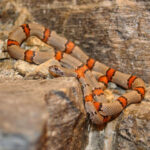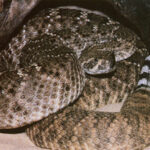Everyone has heard the stories: larger than life snakes rising from the deep recessed shadows, snatching a human into its clutches only to slowly digest him or her live. Have you heard a story similar to this?
This is a sample of one of many myths and stories perpetuated-incorrectly-about snakes. This article is to address the ten most common myths about snakes, and offer the truth behind them.
Myth #1
Snakes are slimy and clammy to the touch.
Truth
This is incorrect. No snake is slimy. Their scales are actually quite smooth, and glides easily over skin; not an ounce of slime present. Likewise, snakes are not clammy. Depending on where you find one at, it will be either warm or cool to the touch. This is because snakes cannot create their own body heat. Therefore, they are the temperature of the environment where you find them.
Myth #2
All snakes have fangs, and a bite from one will hurt severely and lead to death.
Truth
Not all snakes have fangs, nor do they all have venom, and contrary to popular belief, many snake bites do not hurt.
Only venomous snakes have fangs: copperheads, cottonmouths, vipers, etc. Snakes such as boas and pythons do not possess fangs. A few species of snakes possess ‘rear’ fangs, such as a Hognose. However, these fangs are far back in the mouth, hence their name, and even if the snake does bite, you aren’t likely to get caught by those rear fangs.
Usually, a snake bite does not hurt. Small colubrids, such as corn snakes and garters, rarely ever bite, and when they do, it is hardly painful. Even a larger snake will not hurt nearly like one would expect. The level of pain you feel comes down to what the snake wants you to feel. If it wants it to hurt, it will, no matter its size. Luckily, most are nothing more than pricks on the flesh.
Myth #3
Pet boas and pythons can eat you.
Truth
Not true. Most pet pythons and boas will never reach a size where that even becomes a possibility. Ball Pythons, Jungle Carpet Pythons, Red Tail Boas…none of these get anywhere near the size to eat their master.
Likewise, for those who keep Burmese, Reticulated Pythons, and Anacondas, the odds of being eaten by their snake are non-existent. Burmese have been known to kill their owners, usually because of the keepers’ lack of knowledge and caution, but never has it been recorded of a pet snake eating its master.
Myth #4
Snakes carry large amounts of Salmonella, and will make you sick.
Truth
While snakes do carry Salmonella, the odds of becoming infected by it are very small, if properly cared for. One must use common sense when handling a snake. Never allow it in your mouth (I’m not aware of anyone who actually does this), and always wash your hands after handling the snake. Using an antibacterial gel works fine.
Always remove feces and urine from a snake’s cage as soon as it happens, as the feces are where Salmonella is contracted. If your snake happens to slither through it, give the snake a warm bath to clean it, clean the bedding, and then replace the snake. Be sure to wash your hands.
Finally, be sure to scrub the cage once a month. Completely remove all objects, scrub the cage with a light bleach solution, rinse thoroughly, and after it has dried and has no fumes, replace everything. As long as the cage and snake are properly maintained, and you wash your hands, the odds of becoming sick from a snake are very slim.
Myth #5
Snakes can hypnotize humans and animals with their eyes.
Truth
This is not true. A snake cannot hypnotize a person or animal in any way.
Myth #6
Hoop snakes. This is by far my favorite myth, as I almost wish it was true. The myth goes that whenever a hoop snake is scared, it will bite its tail, form a circle-or hoop-shape, and then roll away like a wheel. Another version of the myth says that it will form a hoop shape and then chase the offender.
Truth
Unfortunately, this myth is just that-a myth. There is no such thing as a hoop snake. No snake will bite its tail and form a hoop; it is an anatomical impossibility for their body structure. If a snake is frightened, no matter the type, it will slither away on its belly, not roll away like a wheel.
Myth #7
Hognose snakes (also called Hoggies and Puff adders) can breathe out vaporous venom that is fatal up to a distance of about 20 – 25 feet.
Truth
Hoggies don’t have vaporous venom-in fact, they don’t have any venom. This myth likely originated because Hoggies, when threatened, will puff up their necks like that of a cobra, and hiss wildly. However, if you were to continue bothering it, it would eventually stop with the faux cobra act and flip over onto its back, becoming limp and lifeless. They are not poisonous, they are simply cowards.
Myth #8
A snake can only bite you if it is in a springing, coiled position.
Truth
I can speak from experience that this is indeed a myth. The scar between my right index finger and thumb from a very angry Ribbon snake attests to the fact that they can strike from any position, including from the feet of an over-anxious 11-year-old.
Myth #9
Milksnakes like to sneak up on cows and suck the milk right from its source.
Truth
Wrong! They may be called Milksnakes, but they are like any other snake. Try to give it milk, and you will get a very confused, possibly amused, Milksnake.
Myth #10
Last is the myth that there are cottonmouth snakes in the New England area.
Truth
This is false. There are no cottonmouth snakes in New England. They are very prominent in the Southeaster states, but are not found in the north. What most people assume is a cottonmouth is most likely a North Water snake. These snakes look nearly identical to a cottonmouth; growing up in Ohio right next to a creek, I’ve run away from more than one ‘cottonmouth’.




